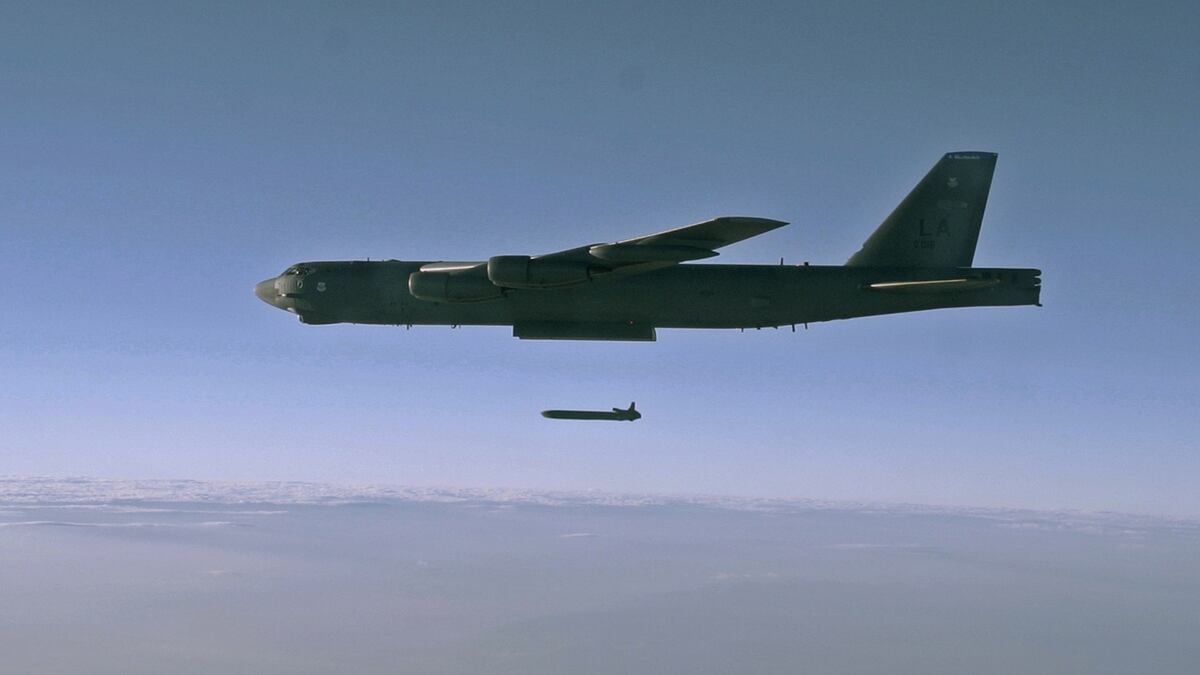
An unarmed AGM-86B Air-Launched Cruise Missile is released from a B-52H Stratofortress over the Utah Test and Training Range during a Nuclear Weapons System Evaluation Program sortie Sept. 22, 2014. C(Staff Sgt. Roidan Carlson/Air Force)
WASHINGTON — Raytheon will get up to $2 billion to develop the Air Force’s Long Range Standoff Weapon system, a new nuclear-capable air launched cruise missile that will be carried by B-52 and B-21 bombers.
The service on July 1 awarded Raytheon a cost-plus-fixed-fee deal for the engineering and manufacturing development stage of the LRSO program, with contract options that max out at about $2 billion.
During the EMD stage of the program, Raytheon will continue to mature its LRSO design and prepare for full-rate production of the weapon in 2027, the contract announcement stated.
LRSO is slated to replace the AGM-86B Air Launched Cruise Missile, which was designed in the 1970s. Air Force officials have argued that the legacy ALCM has become more difficult to maintain as its supply base becomes obsolete, and its effectiveness gets increasingly compromised as adversaries field more sophisticated air defense systems.
The Air Force could buy more than 1,000 LRSO missiles, which are projected to have a range in excess of 1,500 miles.
During a July 2 briefing, Pentagon spokesman John Kirby said the Defense Department aims to keep LRSO development on track, even as it executes a nuclear posture review that could eventually call for the weapon’s cancellation.
The Pentagon’s fiscal 2022 budget requests fully funding for the military’s nuclear modernization priorities, including $609 million for the LRSO program. That money ensures that the efforts like LRSO, the B-21 bomber and the Columbia-class submarine proceed, even as the department studies whether to make changes to the nuclear enterprise.
“As we continue with nuclear modernization we are going to continue to review ongoing programs to assess their performance, schedule risks and projected costs so you can define the right balance of maintaining the necessary nuclear capabilities with cost effective solutions,” Kirby said.
The Congressional Budget Office estimated in December 2020 that the Pentagon would save $12.5 billion from FY21-FY30 by canceling the LRSO program and the W80-4 warhead that it will carry.
However, the Air Force announced last year that it would sole-source the LRSO design developed by Raytheon, effectively booting Lockheed from the competition two years early.
“Our competitive TMRR phase, which included both Lockheed Martin and Raytheon as the prime contractors, enabled us to select a high-confidence design at this point in the acquisition process,” Maj. Gen. Shaun Morris, who leads the Air Force Nuclear Weapons Center, said at the time.
In 2017, Raytheon and Lockheed Martin received contracts worth about $900 million for the 54-month technology maturation and risk reduction phase of the LRSO program. At the time, the service planned to downselect to a single vendor in fiscal year 2022 during the EMD period.

Raytheon wins $2B contract for new nuclear cruise missile
Raytheon Technologies will move the Long Range Standoff Missile into the next phase of development.


